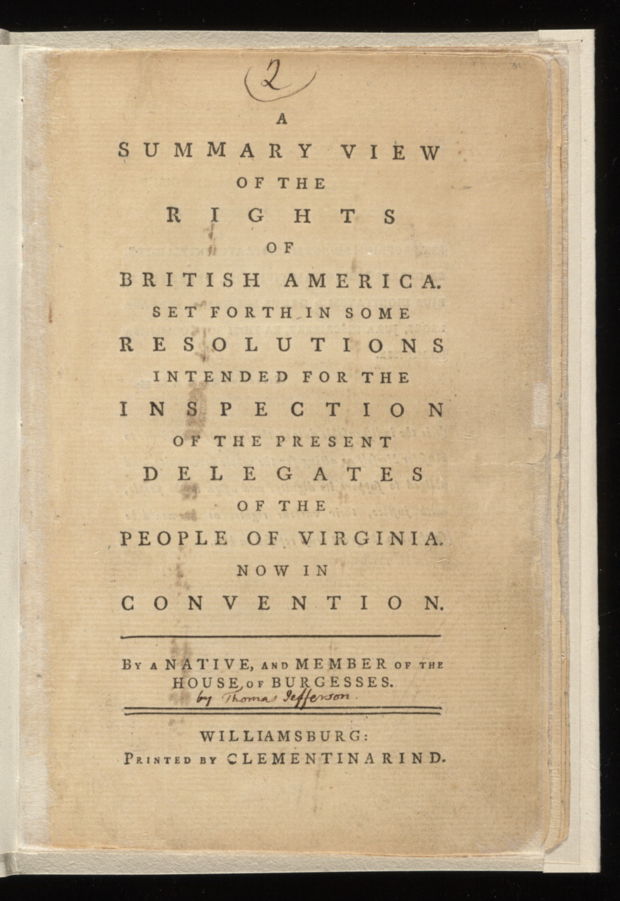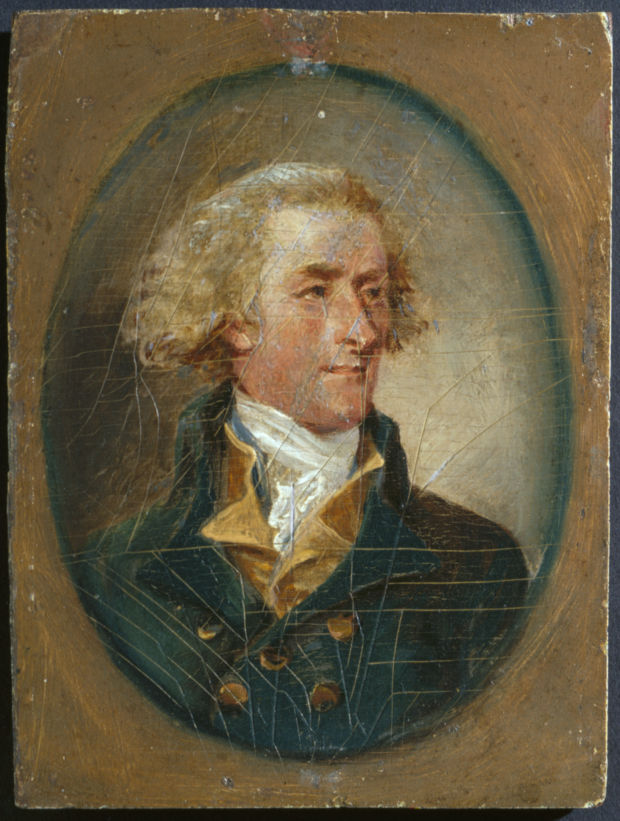Jefferson and the beginning of the American Revolution
Reading Level: Middle School
From 1775 to 1783, American Patriots fought the British in the American Revolution. Thomas Jefferson never fought as a soldier. However, throughout the war, he used words and deeds to further the cause of independence. He was a delegate in the Virginia House of Delegates and the Second Continental Congress, governor of Virginia, author of the Declaration of Independence, and a spokesman for liberty.

This map by Carington Bowles shows the boundaries of the American colonies in 1763 following the French and Indian Wars.
Background to the American Revolution
When the war between France and England ended in 1763, Great Britain had won. At the time George III was king of Great Britain. He and his ministers (persons in charge of government departments) wanted to keep strict control over their colonies in America. By 1775, the thirteen colonies had a population of more than 2,700,000. Most people lived on small farms and exported agricultural products to England. They imported manufactured goods such as cloth, hats and tools from England. Each colony had its own governor and assembly.
The war had been expensive. The British Parliament placed new taxes on the colonies to help pay off the debts. The 1764 Sugar Act and 1767 Townshend Act placed taxes and duties (fees) on imported goods. Colonists refused to pay the taxes. They stated that since they had no representation in parliament, they had not voted for the taxes. However, even worse, Parliament passed the Quartering Act. This act said that British soldiers could be housed in any empty, public building.
In 1768 British Redcoats (soldiers) occupied Boston to punish the city for its resistance against the taxes. In 1770, Redcoats fired on a mob, killing five colonists. It was called the Boston Massacre. In 1773, in reaction to the tax on tea, colonists threw 342 tea chests into the Boston Harbor. The British Parliament closed Boston Harbor and in 1774, imposed harsh regulations. The colonists called them the “Intolerable Acts”.

Title page for Jefferson’s copy of his A Summary View of the Rights of British America, which he wrote in 1774.
“The God who gave us life, gave us liberty
Thomas Jefferson had strong views on independence. As a farmer in the ‘wilderness’ of Virginia, he knew that people could govern themselves. He was elected in 1768 to the Virginia House of Burgesses. (This was called the House of Delegates after 1776). As a burgess, he protested the Townshend Acts.
Jefferson wrote a series of resolutions (opinions) on the colonists’ struggle. Jefferson said that the colonists were a free people claiming their rights. The resolutions were later published as A Summary View of the Rights of British America. Colonists outside of Virginia read A Summary View and became aware of Jefferson’s talents as a writer and thinker.
The First Continental Congress
Before the Revolutionary War, the colonies had no central government that met in America. State governments were just being established. In reaction to British taxes and acts, delegates from twelve of the colonies met in Philadelphia. (Georgia was not represented.) They called themselves the First Continental Congress.
The delegates wanted King George and Parliament to end his harsh policies. They sent King George their “Declaration of Rights and Grievances”. At this time, the delegates did not speak of independence. They wanted to restore harmony. However, they did prepare for conflict. The delegates urged colonists to stop buying British goods and form militias (local armies of citizens). Gunsmiths made muskets. Firearms and ammunition were secretly stored in barns where the king’s soldiers could not find them. The delegates vowed to organize a Second Continental Congress if Great Britain did not repeal the Intolerable Acts.
Richmond Convention
In March 1775, Jefferson was elected to attend a Virginia convention held in Richmond. Patrick Henry spoke at the convention. He believed that Great Britain threatened the colonists’ independence. “I know not what course what others may take, but as for me, give me liberty or give me death.” Jefferson supported Patrick Henry’s call to arms. The convention approved the decisions made by the First Continental Congress.

Miniature portrait of Thomas Jefferson by John Trumbull
The Revolution Begins
On April 19, 1775, British Redcoats marched on Lexington and Concord, Massachusetts. Ninety-four colonists died or were wounded. 272 British died or were wounded or missing. It was the beginning of the Revolution. Messengers spread word of the conflict. Anger and fear raced through the colonies. The message took about two weeks to travel to Virginia. Thomas Jefferson wrote that a “frenzy of revenge seems to have seized all ranks of people.”
Lord Dunmore, governor of Virginia, called a meeting of the Virginia government. Thomas Jefferson attended. Dunmore assured Virginians that no more taxes would be levied (forced to be paid). Colonists could voluntarily pay the taxes to Great Britain. Jefferson responded that Virginia was now represented by the Continental Congress, not by British Parliament. The assembly chose Jefferson as a delegate to the Second Continental Congress.
The Second Continental Congress
On May 10, 1775, the Second Continental Congress met in Philadelphia. In June, Thomas Jefferson took his seat. The delegates from Virginia also included George Washington and Richard Henry Lee. Congress quickly approved a plan to raise troops and send them to Boston. Jefferson was asked to write a statement explaining the colonists’ reasons for declaring war. Jefferson used many of his ideas from A Summary View. Congress also appointed George Washington as commander in chief of the armies of Congress. Two weeks later Washington began to create an army of volunteers. The British realized that the colonies were serious about the war.
In July the Second Continental Congress approved two resolutions to send to Great Britain. They included the Olive Branch Petition, which was addressed to King George. At this time, the Patriots blamed Parliament, not the king, for the problems. The delegates expressed their hopes for peace.
The second resolution was the “Declaration of Causes and Necessities for Taking Up Arms.” In this resolution Jefferson wrote, “Our attachment to no nation on earth should supplant our attachment to liberty.” The resolution stated that the colonists would fight to resist British’s harsh treatment. However, they still hoped to keep peace between the countries.
King Georges Answer
In August 1775, King George rejected the Olive Branch Petition. He stated that the colonists had forgotten “the power that has protected and supported them.” At the time, the king and Parliament believed the Patriots were few in number. They gathered an army of 20,000 to crush the colonists. They also seized American ships.
The Second Continental Congress responded. They voted to form a navy and find foreign aid to help pay for a war. In April 1776, they closed seaports to British ships. They funded a Continental army. This included regiments (group of soldiers) raised by Congress and regiments from the states.
Revolution!
By early May, Jefferson was well enough to resume his job as a delegate to the Second Continental Congress. After a week’s journey, he arrived in Philadelphia. Later, he rented a bedroom and parlor in a brick building on Market and Seventh Streets.
While a delegate, Jefferson met with committees and drafted reports and letters. He also wrote a list of charges against King George III to send to Virginia’s assembly. At the time, Virginia was forming its own government and constitution. These charges and ideas became part of Virginia’s constitution.
On June 7th 1776, Virginia delegate Richard Henry Lee presented an important resolution to Congress. “These united colonies are and of right ought to be, free and independent states;” John Adams seconded the Lee Resolution but only seven colonies voted for it. New York and Pennsylvania were against the resolution. South Carolina and Maryland wanted more time.
The delegates continued to argue over the Lee Resolution. Like Thomas Jefferson, John Adams was for independence. Jefferson wrote that Adams spoke “with a power of thought and expression that moved us from our seats.”

